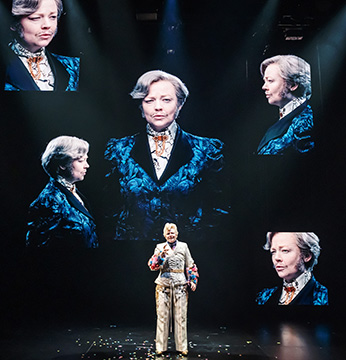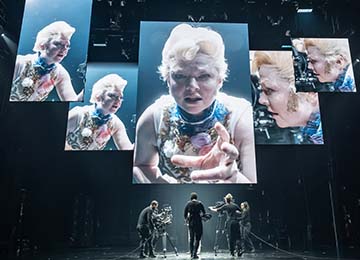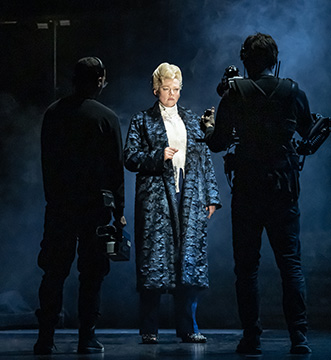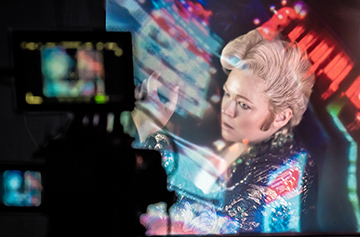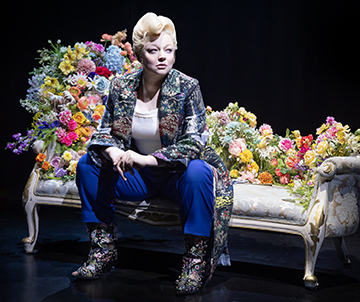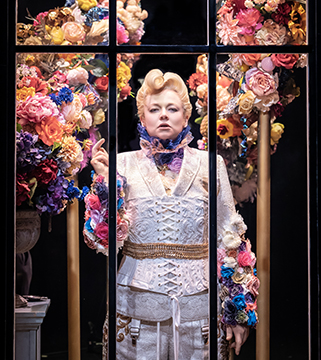By Lucy Komisar
Sarah Snook is brilliant as Dorian Gray and all the other 25 characters in this morality play about the decadent British upper class.
The Oscar Wilde novel, written in 1890, is about a young self-centered fop who doesn’t want to grow old, and, after his portrait is painted by a friend, makes a pact with the devil (as it were), to have his face stay the same while the ravages of time and his excesses are shown on the painting secreted in his childhood playroom.
The stage adaptation is by Kip Williams, who is also director.
Dorian/Snook is surrounded by five videographers with handheld or wheeled tripod cameras. Your gaze shifts from stage to screen, but mostly to the screen above the stage. The magic is effected by seamless positioning of the filmed or live actor into or next to a video where she interacts with the other persons (all herself), and where the film shows every expression of her up-close face/faces, every nuance of personality.
Dorian, with curly blonde hair, pouty lips, a quizzical smile, wears blue pants and white blouse with lace sleeves. A dresser attaches a moustache. (Yes, the dresser is on stage to change Snook’s clothes and look according to the character.)
Cameras chase after her.
Dorian’s amoral mentor Lord Henry tells him, “The aim of life is self-development, to realize one’s own nature perfectly.” He warns him that someday he will be old and wrinkled. “You charm the world. Will it always be so? … A new hedonism–that is what our century wants.”
His friend, the painter Basil, with mutton chops and red jacket, paints his portrait. Dorian observes, “I shall grow old, and horrible, and dreadful. But this picture will remain always young. … If it were only the other way! If it were I who was to be always young, and the picture that was to grow old! … I would give my soul for that!” The Faust character speaks!
Eternal youth would provide infinite pleasure, but the portrait would bare his shame. He locks it in the playroom.
Sometimes a redhead narrator speaks in a picture frame set high in the backdrop.
My favorite scene is a dinner, where, thanks to video magic, seated next to Dorian is Lady Agatha (with red hair and jewels). Then the Duchess of Harley (who holds a dog), Sir Thomas Burdon, a rotund member of Parliament (with bad teeth), his neighbor Erskine of Treadley, a gentleman of charm, but, the narrator says, lacking in personal hygiene, and at the end Mrs. Vandeleur (with a great face) who “had fallen into bad habits of silence, having said everything that she had to say before she was thirty.” So much for the British aristocracy.
Dorian is infatuated with the actress Sibyl Vane. We see her as a head with long blonde curls that appears planted on the stage. She has a twisted face and speaks terribly. Dorian declares, “It is not good for one’s morals to see bad acting.” He will break up with her; she commits suicide.
He explores perfume, music, jewels, fashion. A filter distorts Snook’s face. At parties the photo shimmers. But things are being said.
Dorian’s painter friend Basil says, “I think it right that you should know that the most dreadful things are being said against you in London. Mind you, I don’t believe these rumors at all. At least, I can’t believe them when I see you. Sin is a thing that writes itself across a man’s face. It cannot be concealed. If a wretched man has a vice, it shows itself in the lines of his mouth, the droop of his eyelids.
But… Why is it, Dorian, that a man like the Duke of Berwick leaves the room of a club when you enter it? Why is it that so many gentlemen in London will neither go to your house or invite you to theirs? Why is your friendship so fatal to young men? There was that wretched boy in the Guards who committed suicide.”
Dorian replies, “You ask me why Berwick leaves a room when I enter it. It is because I know everything about his life, not because he knows anything about mine. My dear fellow, you forget that we are in the native land of the hypocrite.”
Basil knows too much, and Dorian stabs him to death. He threatens exposure of ex-lover Alan Cambell to force him destroy the body with chemicals. His face is distorted, like a funhouse picture.
Fast forward: Sibyl’s brother James has hunted Dorian for 18 years. He wants to kill him. But Dorian argues that the man who provoked Sibyl’s suicide must have been 20 years old then, suggesting he would look much older than Dorian does at present. Perhaps he doesn’t notice that Dorian wears a corset over his white jacket.
Later James will be persuaded he has his man. And there’s a chase in the woods. When he confronts him, he will ask, “Tell me, Mr. Dorian, what does it profit a man if he gain the whole world and lose–how does the quotation run?–his own soul’?”
Dorian pulls off the corset.
It is an astonishing production. Kip Williams has created a masterpiece worthy of Wilde. It could not exist without video designer David Bergman’s creativity, showing not only each individual but characters interacting. And Marg Horwell’s set and costumes that summon up the period in all its color and self-indulgence.
“The Picture of Dorian Gray.” Based on the novel by Oscar Wilde, stage adaptation and direction by Kip Williams. The Music Box Theatre, 239 West 45th St, NYC. Runtime 2 hrs. Opened March 27, 2025, closes June 29, 2025.


